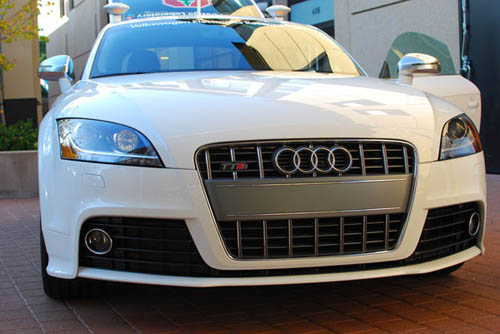
Stanford University is already famous for its autonomous robotic vehicles, including Stanley (who won the DARPA Grand Challenge in 2005) and Junior (runner up in the DARPA Urban Challenge in 2007). This weekend, Stanford held an event to showcase their partnership with Volkswagen on a new $2 million autonomous innovation laboratory. On display was Stanford’s latest autonomous vehicle, a robotic Audi TTS named Shelley. Shelley currently holds the unofficial world speed record for an autonomous car at over 130 mph, and will be racing up Pikes Peak all by herself next year:
Stanford also demonstrated an autonomous valet parking system, where an almost stock Volkswagen Passat entered a parking lot, located an empty space, and parked itself:
We’ve got a bunch more details over on BotJunkie:
[ Pikes Peak Audi TTS ]
[ Autonomous Valet Parking ]
[ Volkswagen Automotive Innovation Laboratory ]





This stuff is pretty awesome, now all they have to do is drastically reduce the size of the equipment needed and implement it into all modern cars so that the people who don't…. oh wait why don't you just learn to park your car yourself, I mean parallel parking really isn't that hard and it along with being able to have cars stop themselves is really the only practical application for automation in vehicles unless you are going to make all the cars automated and how practical is that. People will become so much more technology dependent.
Drastically reduce the size of the equipment needed and implement it into all modern cars? Watch the valet parking video and tell me how much equipment you see… Except for 2 little bumper sensors, it's a Volkswagen Passat that you could buy in a showroom. Check out the read link for details.
And the thing about the Audi is that it's designed to develop a an autonomous system that can take over for you in the event of an imminent crash. You car will be able to execute an escape maneuver that a human wouldn't have the time or ability to pull off.
Can't wait till they put these on the market.
When I can sit in a car and have it drive me to work every day, come and wake me up. Till then, don't.
I watched one of these races a couple of years ago when one out of 10 finished the course. Then I watched the paint drying competition on my living room wall. I prefer paint.
I live in Colorado Springs. The Pikes Peak hill Climb next year is June 27th, and I go to the race every year. I'll try and grab some video of the car in action next year.
If they can keep up the speed, it should be rather awesome. There are a couple of tricky turns that people have problems with, the combination of dirt road and speed make for some really nasty slide-flip combinations.
The barrier for them to beat and actually get a lot of interest is the 12 minute mark. Tht is where most people qualify. The record for the race is Robby Unser's 10:05.58. The record for all electric is around 15 minutes.
The hill climb is istance of 19.99 km (12.42 miles) over 156 turns, climbing 1,439 meters (4,721 ft) from the start at Mile 7 on Pikes Peak Highway at 2,862 meters (9,390 ft) on grades averaging 7% over both gravel and paved sections.
Can't wait!!!
Forgot to mention that the race in 1987, that Walter Rohrl won, he came across the finish line with 4 flat tires.
http://www.botjunkie.com/2009/10/26/vail-demons…
go look at that site scroll down to the middle of the page and tell me if you now see the equipment I am talking about.
If you read the article, though, it turns out that all of that equipment in the trunk is just a standard system that Stanford uses to control all of its autonomous vehicles. The actual software running the sensors and the hardware integration could all fit onto the car's own internal computer, it's just easier for them to mess with on their giant rack system.
China Supplier offer Rearview Mirror Car Parking Sensor as low as 30 USD with 4 sensors and 38USD with 8 sensors can use for any cars.
http://www.rearviewmirrorparkingsensor.com/
http://www.media-packs.com/rearview-mirror-park…